.NET is a software development framework and ecosystem designed and supported by Microsoft to allow for easy desktop and web application engineering. It’s a popular free platform currently used for a lot of different types of applications as it provides the programming environment for most software development phases. .NET best suits businesses that look for a wide range of features like web-based services, desktop software, and cloud infrastructure support.
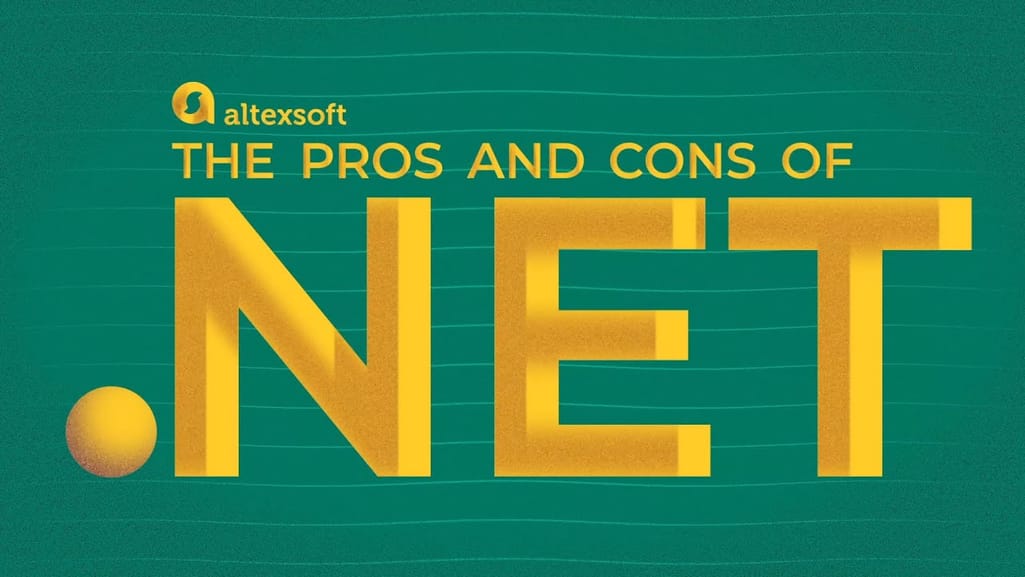

.NET in 16 minutes or less
The history behind .NET: from the .NET Framework first release to .NET 6
Microsoft started working on the .NET Framework in the late 90s. The idea was to create a platform based on so-called managed code, code that can be executed under a runtime environment. This was needed to improve the development experience and relieve engineers from handling security operations, active memory management, and other low-level efforts that C/C++ developers had to bother with.
The .NET Framework era
The first release of the .NET Framework in 2002 introduced C#, a language for writing managed code that had a design similar to C++. The framework itself was aimed at Windows-based computers and servers. It had WinForms, a GUI library for desktop applications; ASP.NET, a framework for the web; and ADO.NET for data access. All these elements were driven by Common Language Runtime (CLR) to compile and execute managed code.
To unite various functions, .NET offered a framework class library (FCL) that included the base class library (BCL), a network library, a numerics library, and others.
Since that time, the framework has undergone multiple iterations spanning runtime updates, new desktop graphical systems (WPF), APIs for service-oriented applications (WCF), and more.
The .NET Core era
In 2014, Microsoft announced a dramatic shift in the way .NET exists by presenting .NET Core, a new cross-platform, cloud-friendly, and open-source version of the framework. .NET Core made it to a release in 2016, becoming the main technology to consider for new .NET projects. Gradually, Microsoft started porting existing services to work with Core. Some that didn’t receive official ports, like Windows Communication Foundation (WCF), were substituted by alternatives sourced from the community.
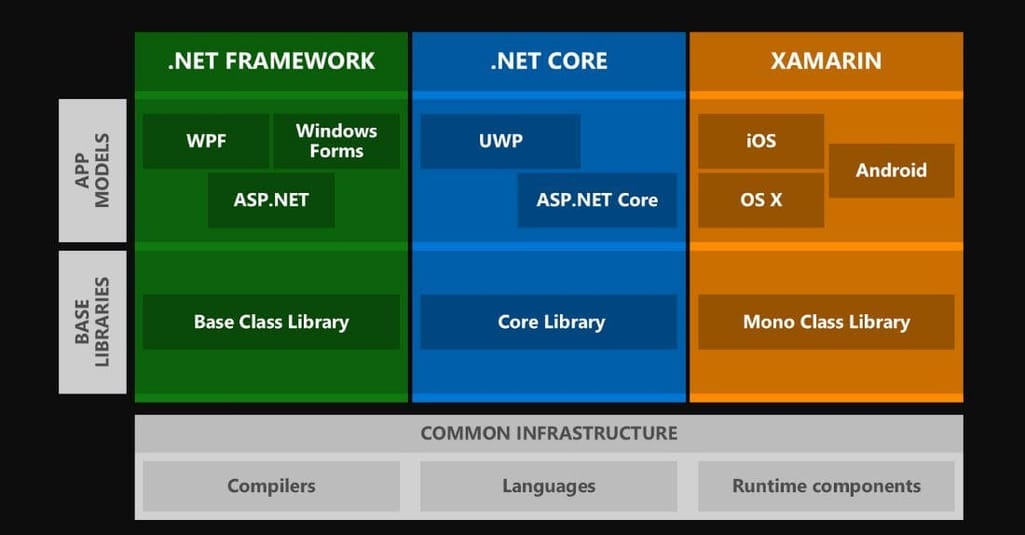
.NET ecosystem before 2016. Source: Cris's coding blog
Also, in 2016, Microsoft acquired Xamarin, previously a proprietary technology for cross-platform mobile development, making it open source as well.
Microsoft continued moving towards “transparency between the product team and the community” and open-sourced Windows Presentation Foundation (WPF), Windows Forms, and WinUI frameworks in December 2018.
The .NET 5 and .NET 6 era
In May 2019, the company announced the big release that would tie the ecosystem together: All .NET elements were supposed to be bundled in the .NET 5 development platform. While changes were made to the schedule because of COVID-19, the .NET 5 unified development platform was finally introduced in November 2020.
The successor to .NET Core 3.1 and .NET Framework 4.8, .NET 5 puts order into the fragmentation of the .NET world and provides many features for building applications on Windows, Linux, macOS, iOS, watchOS, Android, tvOS, or using WebAssembly. The platform comes with new APIs, language features, and runtime capabilities. Also, .NET 5 includes ASP.NET Core, Xamarin, Entity Framework Core, WPF, WinForms, and ML.NET.
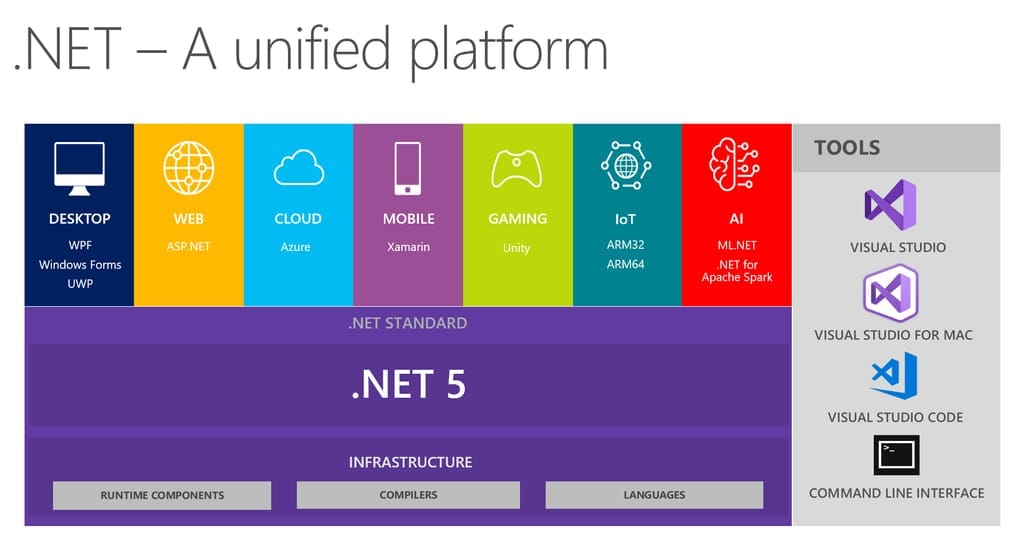
How the .NET platform is organized with the release of .NET 5. Source: .NET Blog
While .NET 5 set the unification foundations, the newest .NET 6 version delivered the final parts of it in November 2021, with Visual Studio 2022 released the same day. This is a unified platform for building projects across cloud, browser, IoT, mobile, and desktop environments, enabling all to use the same .NET libraries, SDK, and runtime.
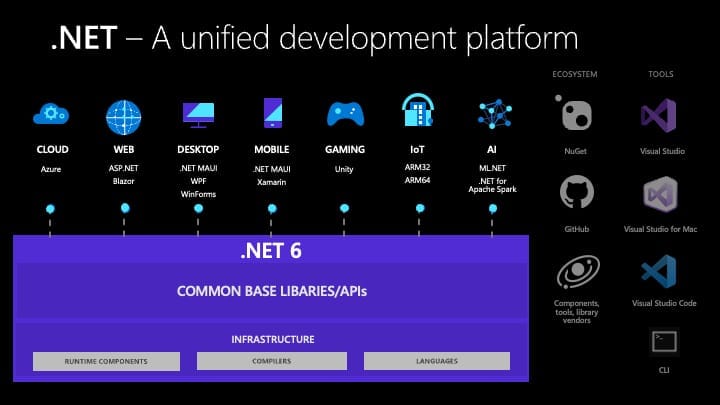
The .NET 6 unified development platform. Source: Microsoft
One of the most prominent .NET 6 features is .NET MAUI (Multi-platform App UI), which acts as the cross-platform framework for developing native desktop and mobile apps with C# and XAML.
Apart from being the final step of the unification, .NET 6 can boast of:
- better performance with decreased project execution time, latency time, and memory use;
- APIs for HTTP/3, JSON processing, mathematics, and direct memory manipulation;
- improved security with support for OpenSSL 3 and ChaCha20Poly1305 encryption scheme; and
- stable version and long-term support for 3 years.
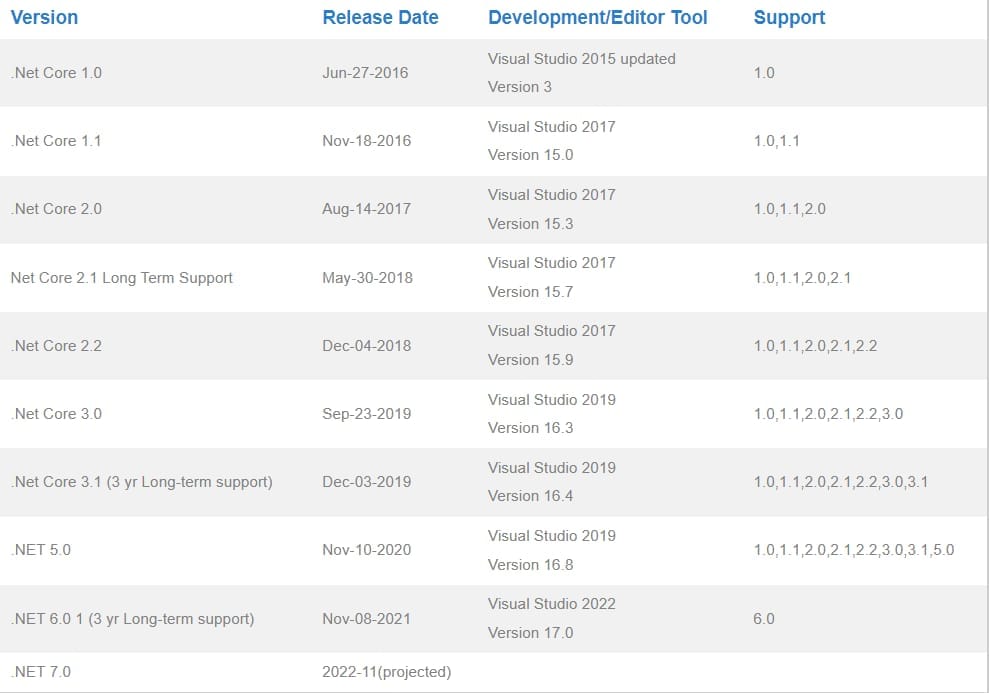
The table shows .NET Core versions and support. Source: Rishabh software
Besides all that, it’s the very first release that has native support for Apple Silicon (macOS Arm64) and improved support for Windows Arm64.
We will partly cover what’s new in .NET 6 in the paragraphs below. Find more information on the Microsoft blog post.
What is the .NET development platform
.NET comes in four flavors: .NET Framework, .NET Core, Xamarin, and Universal Windows Platform (UWP).
These implementations combined are called the .NET development platform. Each contains frameworks and libraries for building various applications.
.NET Framework
The .NET Framework released back in 2002 is the first and oldest implementation of the platform. It includes three main application models – WPF, Windows Forms, ASP.NET Forms – and Base Class Library.
Windows Presentation Foundation (WPF) is a UI framework for creating graphical interfaces, primarily for desktop client applications on Windows OS. It uses the capabilities of Extensible Application Markup Language (XAML).
Windows Forms is a GUI class library within the .NET Framework. Windows Forms are used to develop desktop applications with rich graphics that are easy to update and deploy.
ASP.NET. While the previous two components are designed for desktop engineering ASP.NET is used to develop dynamic websites and web applications. There is the Common Language Runtime (CLR) in its core that gives developers the opportunity to write ASP.NET code using different .NET languages that we discuss below.
Base Class Library (BCL) provides the most common functionality, such as classes in namespaces, and is the core of the Framework Class Library (FCL), a set of reusable interfaces, classes, and value types that are closely integrated with the Common Language Runtime (CLR). The combination of FCL and CLR constitutes the .NET Framework. The base class library also includes ADO.NET, data access technology used by developers to access databases.
As the .NET Framework supports only Windows-based devices, there was a need for a cross-platform package.
Learn how AltexSoft implemented a blog section using the .NET Framework
.NET Core
.NET Core was released in 2016. It’s a cross-platform version of the .NET Framework: Engineers can now use the product on Linux and macOS and create applications that aren’t necessarily tied to the Windows family. The new system aims at conquering the cloud space as some providers like Digital Ocean are Linux-driven. Not only is .NET Core cross-platform, but its different versions can also be installed side by side on the same device. .NET Core includes ASP.NET Core and Universal Windows Platform (UWP).
ASP.NET Core is a cross-platform rebuild of ASP.NET that is a more modular framework than its predecessor. It allows you to build the mobile backend, web apps, and services.
In .NET 6, ASP.NET Core has many new features, including Hot Reload, which enables the application of changes to C#, Visual Basic, and CSS source files without having to restart or rebuild the app (the app is running while you are updating the code).
Xamarin
The third implementation is called Xamarin and is used for mobile applications and Mac products. Originally, Xamarin was designed independently of Microsoft and was a proprietary product. Then Microsoft acquired it in 2016 making it a fully open-source branch of the .NET platform. Xamarin uses the Mono runtime and a version of the .NET Framework adjusted to work with APIs for iOS, Android, and Xamarin.Mac.
To get an elaborate overview of this product, check our Xamarin pros and cons article.


Pros and cons of Xamarin development
All runtimes use a common infrastructure that makes the entire ecosystem work. It provides runtime components, languages, and compilers.
Universal Windows Platform (UWP)
UWP provides a common type system, APIs, and application model for all devices running on Windows 10. Thus, it enables the development of universal apps for PCs, tablets, Xbox, Surface Hub, HoloLens, and Internet of Things (IoT) devices.
UWP app developers get access to the Microsoft Store, which charges only 15 percent for non-gaming subscription-based apps, unlike the Google Play Store and App Store. Other services include an execution environment (AppContainer) and Extension SDKs to call specialized APIs for different devices.
Unfortunately, .NET 5 and .NET 6 will not be coming to UWP project types, and there will not be an update on UWP regarding this.
.NET Standard
In 2016 Microsoft also introduced .NET Standard, a library that combines APIs from .NET Framework, .NET Core, and Xamarin. This allows engineers to use a single base-class library rather than mastering three different ones related to each .NET implementation. This step unified the ecosystem and brought a greater consistency to reusing components across different platforms.
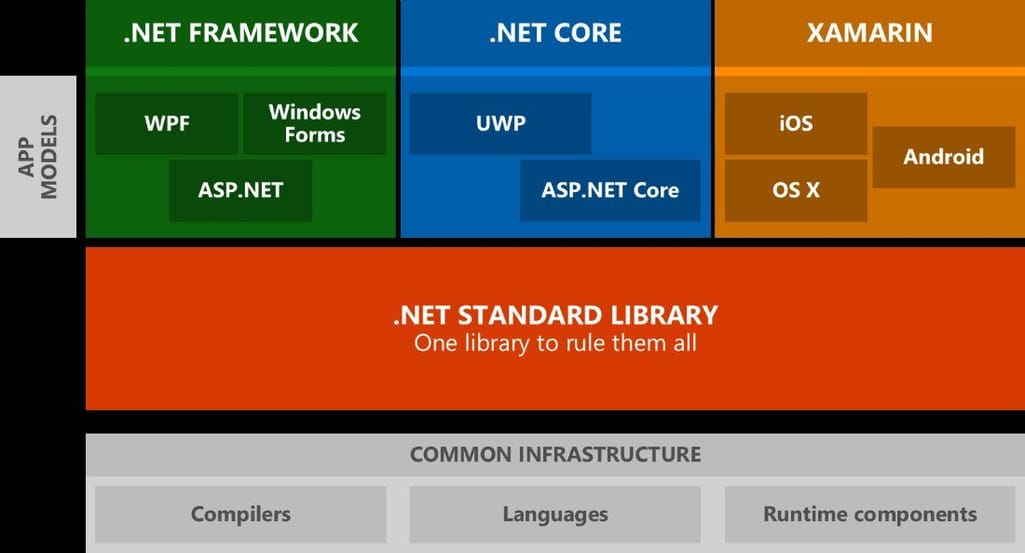
.NET ecosystem after 2016. Source: Cris's coding blog
The .NET development platform is best served by Visual Studio IDE, which is used for building, debugging, and publishing applications across all platforms and devices.
Common language runtime (CLR)
Common Language Runtime (CLR) is the heart of .NET, an application virtual machine that manages memory, implements code access security, verifies code safety, and provides execution of threads and code. CLR is what makes the .NET code a managed one.
As we mentioned, the idea of CLR is to make the developer’s life easier. Besides, it allows engineers to design systems with multiple languages, as CLR enables them to communicate and integrate their behaviors. The runtime checks the needed versions of applied services to ensure that all dependencies are intact and the code works as intended.
In .NET Core, an open-source CoreCLR is used. While nearly identical to CLR in the .NET Framework, CoreCLR is adjusted to the .NET Core cross-platform makeup.
Supported languages
The languages that you can use with .NET can be ultimately divided into two major groups: 1) the main officially supported languages by Microsoft, and 2) the rest of the languages that are CLI-compliant.
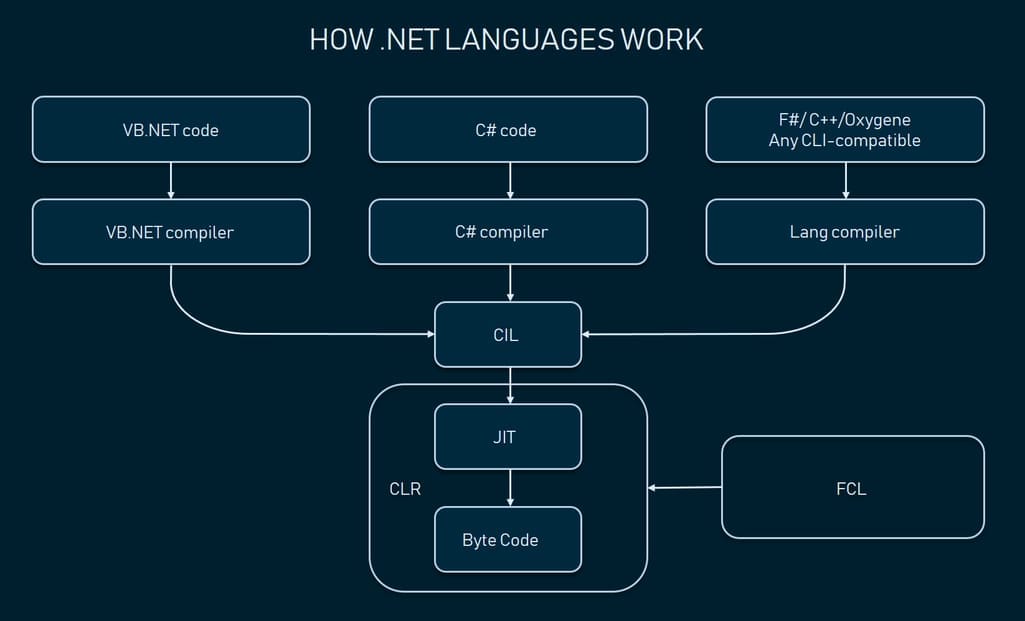
.NET languages
Main languages. Most .NET development happens with C#, F#, and Visual Basic. All three saw great improvements within the .NET 6 release. C# 10 and F# 6 were introduced, both aiming to simplify code and make it more performant.
The rest of CLI-compliant languages. CLI means common language infrastructure. It’s a technical standard for high-level languages that can be compiled into a common intermediate language (CIL) and further compiled into a byte code. Besides those three mentioned above, there are about 25 active CLI-compliant languages, including C++/CLI, IronPython, Oxygene, Phalanger, and more. There’s also a number of languages that are no longer used, like IronRuby.
.NET starter pack
If you’re just starting with .NET, here are some useful links for the beginning of your journey:
.NET guide – the general documentation by Microsoft for newbies;
.NET Core guide – for those considering transitioning to the Core version, go here;
.NET framework – the original .NET documentation;
Xamarin – the docs for mobile development;
.NET foundation – the headquarters of the .NET open-source community;
NuGet – the place to find all .NET packages (By the way, Microsoft Visual also supports npm);
Best .NET tools – our take on the best tools, supported by expert opinion;
.NET Core and framework – download it here; and
.NET developer community – all about chatter and support with links to social media, forums, blogs, live workshops, and organizations like the .NET foundation.
Now, let’s look deeper into the advantages and drawbacks of using the .NET development platform. Most of the points can be applied to the entire ecosystem, while some of them relate only to its specific components, which we’ll specify in the respective sections.
Pros of .NET development
Object-oriented software development model
.NET is based on object-oriented programming (OOP). OOP is a development model for breaking down software into smaller pieces that are easier to manage and combine. OOP compartmentalizes data into objects, i.e., data fields, and describes objects’ behavior and contents through the declaration of classes.
A modular structure helps define the objects' behavior and interactions without managing their inner attributes. OOP simplifies programming by making the code manageable, easier to test and respond to recurring issues. It also eliminates unnecessary programming and generally means less coding for developers. .NET makes it possible to reuse code and components, save time, and – subsequently – the cost of development.
Reliable and simple caching system
Caching means keeping data in a temporary storage place to call it faster when needed. The stored data is the result of an earlier information request or the duplicate of information stored in other places that would take longer to retrieve.
The .NET caching system is robust, simple to use, and extensible. The Object Cache class allows developers to create a custom cache implementation to improve the performance and scalability of Windows client and server applications.
Visual Studio IDE
An Integrated Development Environment (IDE) is a single product for programmers that makes application development easier by providing all the tools needed to write and test software.
Visual Studio is a Microsoft IDE used for building, debugging, and publishing applications across all platforms, including Android and iOS. Visual Studio is integrated with .NET and provides the features of a language-specific environment.
The key features of the Visual Studio IDE:
- It’s used as a single IDE for all .NET applications.
- The IDE has integrated compilation and debugging features.
- Collaborative features include a Git-first workflow, real-time collaboration on the same codebase, and integrated code reviews.
- The solution can be used for applications based on code written in different languages.
- Visual Studio allows for customizing the environment to match user preferences.
Additionally, Visual Studio Marketplace offers a wide range of editor extensions from Microsoft and other providers to enable team collaboration, continuous integration, third-party connections, cloud development management, etc.
The all-purpose IDE Visual Studio 2022 was released in November 2021 along with .NET 6. The rollout is the first 64-bit version of the IDE itself and is stuffed with useful features. Among other things, Visual Studio 2022 contains IntelliCode—special capabilities that use Machine Learning to complete chunks of code for you, recognize repeated edits, and suggest fixes.
Cross-platform design of .NET Core
.NET Core is a cross-platform .NET implementation that allows the code to run on macOS, Windows, and Linux. Unlike the original .NET framework – which is not completely open – .NET Core has a fully open-source code that ensures that a wide engineering community can continuously contribute to its development.
If you write in C#, F#, or Visual Basic, your code will run on each of the compatible operating systems. This enables companies to reach the widest variety of platforms, staying within the .NET ecosystem. At the same time, the cross-platform design ensures that the whole .NET community, with a large pool of different engineering skill sets, shares the experience.
Flexible deployment and easy maintenance
One of the important .NET Core features is flexible deployment. It can be installed as part of your application or require a separate installation. The modular design contemplates including all the dependencies you need. The deployment itself is as easy as copying a folder.
Another benefit is that multiple .NET Core versions can run side by side on the same machine to cover different projects and seamlessly perform deployment tasks.
Universal .NET Standard
Since 2016, the .NET ecosystem has been enhanced with a large class library called .NET Standard. It’s based on the number of base class libraries for .NET Framework, .NET Core, and Xamarin. These are used for common functions such as graphics rendering, database interaction, and manipulations with XML documents. The .NET Standard library greatly simplifies developers’ work.
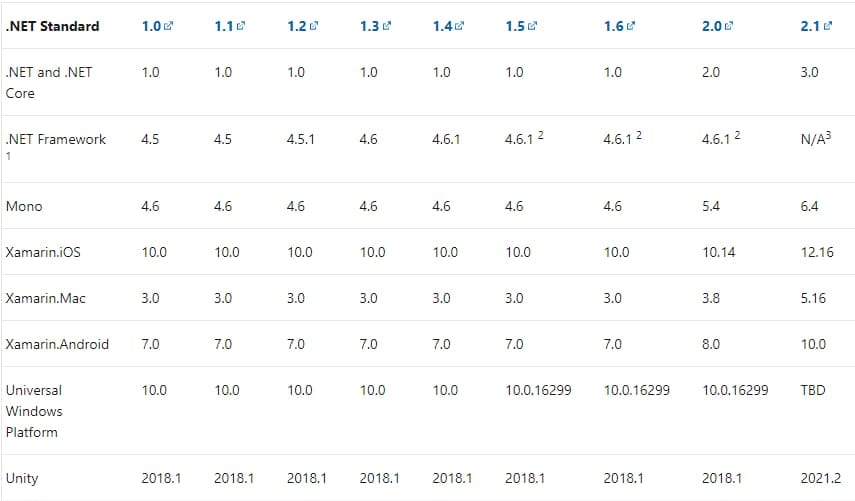
Compatibility with the.NET Standard. Source: Microsoft documentation site
Prior to the .NET Standard, a programmer had to redevelop an application or a library for the new platform and then distribute all the updates across various platforms. Currently, the library supports all dependent libraries across applications. However, you should check version compatibility to leverage the .NET Standard successfully
.NET popularity and community
For those of you who are wondering just how popular .NET is, a large community of developers is the answer. Interestingly, it unites engineers from small, midsize, and enterprise-grade companies. This means that almost any issue can be resolved with the help of community members.
Since .NET Core is open source, its libraries, runtime, and compiler are available on GitHub and have many contributions. According to the Stack Overflow 2021 survey, ASP.NET took fifth place among the most popular web frameworks. At the same time, the .NET Framework with .NET 5 and .NET Core placed first and second, respectively, as the most used frameworks beyond web development.
Besides that, the .NET Foundation fosters open development and teamwork around the .NET ecosystem. .NET community and commercial developers use it as the main forum for idea exchange.
Automatic monitoring in ASP.NET
ASP.NET has built-in automatic monitoring. The Windows Web Server strictly monitors web pages and applications that run on it. If any issues, such as memory leaks or infinite loops, occur, it immediately alerts about them. This allows for directly correcting these behaviors and creating new processes. The monitoring ensures higher stability and transparency of .NET applications.
Powerful Roslyn and RyuJIT compilers
.NET uses two compilers, Roslyn, to compile C# or VB code into CIL (common intermediate language), and RyuJIT, to run just-in-time compilation of CIL into native code. Both compilers are highly regarded by the .NET community as Microsoft actively improves them.
Roslyn has been available since 2011. In 2014, it became open source and in 2015 was included in Visual Studio. In addition to being open source, Roslyn exposes APIs to offer rich code analysis for the developer. This means that, unlike traditional black-box compilation, with Roslyn, developers can read the compilation data at every stage.
RyuJIT is responsible for compiling CIL to byte code. The full transition from the old JIT was completed in 2018 with the idea of improved performance. And, generally, engineers agree that RyuJIT is faster.
According to .NET 5 Preview 1 and Preview 2 released in the spring of 2020, numerous improvements to RyuJIT were made to enhance the quality of the machine code generated by JIT (“code quality,” as Microsoft specialists call it). “In summary, about half of the following improvements are actual new optimizations, and the other half is due to changing the flow of RyuJIT to enable existing optimizations to apply to more code patterns,” noted .NET Team Program Manager Richard Lander.
Active Microsoft support
Since .NET is Microsoft’s platform technology you would expect the company to actively support and develop it. But the point is, Microsoft is really good at what they are doing. Perhaps there’s no other technology company with such a full and coherent ecosystem that checks off all boxes for engineers, from IDEs and frameworks to cloud services.
Microsoft does its best to evolve. The transition to .NET Core was a major step in terms of ecosystem development, as it embraced the cloud and focused on performance improvements.
In 2018, Microsoft introduced the ML.NET framework for C# and F# languages. Also, let’s keep in mind the releases of .NET 5 and .NET 6 are already here with .NET 7 being projected for 2022.
Relatively easy migration from .NET 5 to .NET 6
If you keep your applications constantly updated with the newest .NET versions, migrating from .NET 5.0 to .NET 6.0 won’t be a big headache. You first change the target framework from .NET 5.0 to .NET 6.0 on the Properties of your projects in Visual Studio 2022. Then you upgrade the rest of the packages within the project and run QA processes to see how everything performs.
Unlike the above, the migration from .NET Framework to .NET Core or between some .NET Core versions is not a walk in the park. In case your projects are based on earlier versions like .NET Core 3.1, migrating the app to .NET 5 before making the move towards the latest release is recommended.
Disadvantages of .NET development
Even though .NET is considered one of the strongest engineering platforms out there due to extensive infrastructure and proven product development history, it comes with a set of problems.
Limited Object-Relational Support
As we mentioned above, .NET uses the object-oriented programming (OOP) language model. This model is centered around objects rather than “actions” and data rather than logic. The support of data-oriented software application development in the .NET Framework and Core is provided by the Entity Framework.
An entity is an object-relational mapper (ORM) that links object-oriented .NET Framework and relational (SQL) databases. Some engineers believe Entity Framework isn’t flexible enough and may not support all available database designs. This also means that there’s a chance that, at some point, Entity Framework may not be supporting new database designs. Another problem is that the framework may eventually be abandoned by Microsoft.
On the bright side, you can always choose another ORM alternative, so it remains a debatable point.
Licensing cost
Building .NET apps isn’t cheap, regardless of open source technologies. Mostly, your expenses will be spent on Visual Studio IDE and other additional collaboration and quality assurance services that Microsoft offers to simplify your work.
As of today, the business version of Visual Studio will cost you $45/month for every user. An enterprise release that includes various cloud, enterprise mobility, QA features, and more will be $250 per month per user. However, you still can try to become a Microsoft Partner to have a number of subscriptions for free. For non-profit and educational purposes, there is also the free Visual Studio Community.
Even though you can use .NET Core on Mac and Linux machines, the best way is to use Windows for .NET engineering, which also comes with licensing costs.
The barrier will be even higher if you’ve never used Microsoft products before and you have to migrate from, say, the AWS cloud ecosystem to Azure.
The gap between release and stability
Perhaps, this problem cripples all Microsoft products, not the .NET stack only. But it’s definitely worth mentioning. The newly released products lack proper documentation, support, and stability and are prone to drastic changes. In one of the AltexSoft projects, our architects decided to use a fresh DocumentDB (now Azure Cosmos DB) but then were forced to design custom data architecture as the product suffered a number of technical issues that could jeopardize the entire project.
One of Y Combinator users has vividly described this issue: “My problem with these kinds of Microsoft technology evangelism articles/videos is that it always seems like Microsoft has juuuust gotten their new hotness to work, and is telling the world that it’s awesome, and ready for production. Then you go to implement it, and as soon as you leave the perfect world of their demo, it all falls apart, and THEN you find out the docs were written for the beta version and no longer apply, so you’re left guessing at the right invocation signature for the method you need.”
At the same time, Microsoft keeps working on this issue, and the company’s latest long-term support (LTS) .NET 6 release is claimed to have 3 years of official support and proper documentation on use and migration.
Memory leaks
Memory leaks are not uncommon in any technology. Simply put, the framework doesn’t release the memory that it no longer needs. .NET is frequently criticized for memory leaks and memory-related issues. Although .NET has a garbage collector for this sort of problem, engineers still have to invest additional efforts into proper resource management. And the leaks keep on growing as the application scales.
Fortunately, engineers can find detailed and effective recommendations for detecting leaks in .NET.
Bumpy transition to .NET Core
.NET Core is the next big step in Microsoft’s platform development. As always happens, the transition period may be long and difficult. The applications built with the old .NET Framework outnumber those with .NET Core. And it doesn’t necessarily mean that all of them will experience this transition. In corporate environments, the transition may not be prioritized as much. Nonetheless, these systems need support.
Another related problem here is that the mature .NET Framework had many supporting projects around it. For example, many developers expressed concerns about abandoning Windows Communication Foundation (WCF), a runtime and API set for service-oriented applications used by many .NET practitioners.
Microsoft decided not to port WCF to Core. Instead, they leveraged community effort, as one of the .NET Foundation team members donated an open-source alternative, Core WCF. Again, this isn’t directly managed by Microsoft, nor does it provide full compatibility with the original WCF. Developers will have to spend a little extra effort to complete a transition.
Scott Hunter, from .NET program management, posted that you won’t find ASP.NET Web Forms, .NET Remoting, and some other services in .NET Core. They’ll be gone for good, freeing the way for new technologies.
When to use the .NET
Scalable products. Usually, business needs are growing and your software has to scale with it. .NET provides a scalable environment and allows for redesigning ongoing applications in order to match the growing needs of the business.
Cross-platform needs. In case you need an app that works across platforms, .NET will be a great choice as most platforms are covered and you can reduce development effort while expanding your desktop or mobile app to other operating systems. Also, .NET can be used for such specific engineering cases as gaming (including Xbox) and AR development (including HoloLens).
Enterprise-scale infrastructures. It’s still a debatable point whether .NET is designed mostly for enterprise use. But Microsoft makes sure it provides the widest toolset possible to build and cross-integrate enterprise products, both internal and public ones. It also supports a robust enterprise mobility ecosystem.
This article is a part of our “The Good and the Bad” series. If you are interested in web development, take a look at our blog post on the

